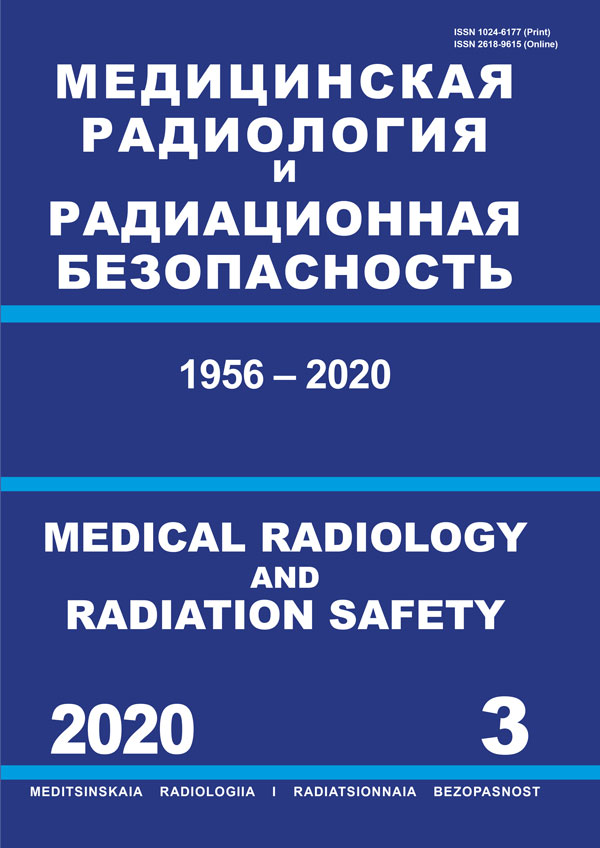Russian Federation
Russian Federation
Russian Federation
Russian Federation
Russian Federation
Russian Federation
Russian Federation
Purpose: The main purpose of the research is to define the group of radiation risk (GRR) on the incidence of hypertension among Russian recovery operation workers of the Chernobyl accident (liquidators). Material and methods: The object of research is the cohort of the Russian liquidators with the known individual doses of external gamma exposure of all body. Definition of GRR on incidence of hypertension is based on assessment of excess relative radiation risk (ERR) and relative radiation risk (RR) in the observed cohort of 106 thousand liquidators, having average accumulated dose of external gamma exposure of all body of 0.11 Gy and the maximum individual doses about 1 Gy. Results: From 1986 to 2012 in this cohort 57112 cases of hypertension have been diagnosed, basically – essential (primary) hypertension (39.2 %) and hypertensive heart disease (53.8 %). The statistically significant ERR of incidence of hypertension was observed only for liquidators who entered the Chernobyl zone of recovery operations within the first year after the accident (before 26.04.1987): ERR/Gy = 0.26 with 95 % CI (0.12; 0.41), p < 0.001. For other liquidators no significant associations between the explosion dose and the incidence of hypertension were revealed. For nonparametric estimates of RR in dose groups (relative to the control group with doses < 0.05 Gy) the statistically significant radiation risk was observed only for the dose group over 0,25 Gy: RR = 1.07 at 95 % of CI (1.02; 1.12), p = 0.023. GRR on incidence of hypertension equal to 4 % of the number of the studied cohort of liquidators: 4515 persons with accumulated doses of 0.25 Gy and higher, arrived to the Chernobyl area within the first year after the accident. In GRR 2597 cases of diseases of hypertension were diagnosed; statistically significant (p = 0.023) assessment of RR is equal 1.07, with 95 % a confidential interval (1.02; 1.12) and an average dose 0.297 Gy. During observation from 1986 to 2012 6.5 % of cases of diseases of hypertension (170 cases) in GRR can be related to radiation-caused ones. GRR for the beginning of 2013 consisted of 2919 persons 1909 of whom had already had diagnoses of hypertension (125 – radiation caused). Since 2013 for lifetime in GRR from 43 to 66 cases of diseases of hypertension which can be related to radiation-caused are expected. Conclusion: As hypertension is the risk factor for many circulatory diseases, address prevention and treatment of hypertension in GRR in the first years after radiation accidents could reduce the radiation-caused loss healthy years of participants of elimination of such accidents.
radiation risk, radiation risk group, hypertension, liquidators, Chernobyl accident, excess relative risk (ERR), relative risk (RR), radiation doses
Действие ионизирующей радиации на здоровье человека при дозах облучения менее 1 Гр проявляется, в основном, в виде долговременных стохастических эффектов, таких как увеличение частоты злокачественных новообразований (ЗНО). Для стохастических радиационных эффектов в настоящее время общепринята линейная беспороговая зависимость «доза–эффект». Механизмы возникновения радиационно-индуцированных ЗНО хорошо изучены, так как традиционно являлись основным предметом изучения радиобиологии. На эпидемиологическом уровне оценки коэффициентов радиационных рисков ЗНО были в основном получены к 1990 г. на когорте лиц, переживших атомные бомбардировки городов Хиросимы и Нагасаки в Японии (когорта Life Span Study, LSS). Эти оценки до сих пор используются для обоснования современ- ной системы радиологической защиты. Когорта LSS наблюдалась с 1950 г. и продолжает наблюдаться в настоящее время, т.е. уже 65 лет.
1. The 2007 Recommendations of the International Commission on Radiological Protection. ICRP Publication 103 // Annals of the ICRP. 2007. Vol. 37. № 2-4. 2007. 332 pp.
2. Pierce D.A., Shimizu Y., Preston D.L. et al. Studies of the mortality of atomic bomb survivors. Report 12. Part I. Cancer: 1950-1990 // Radiat. Res. 1996. Vol. 146. P. 1-27.
3. Shimizu Y., Pierce D.A., Preston D.L., Mabuchi K. Studies of the mortality of atomic bomb survivors. Report 12. Part II. Noncancer mortality: 1950-1990 // Radiat. Res. 1999. Vol. 152. № 4. P. 374-389.
4. Breslow N., Day N. Statistical methods in cancer research. Volume II. The design and analysis of cohort studies. Scientific Publication 82. - Lyon: IARC. 1987. 406 pp.
5. Mezhdunarodnaja statisticheskaja klassifikacija boleznej i problem, svjazannyh so zdorov’em, 10-j peresmotr (MKB-10). T. 1 (chast’ 1). Zheneva: VOZ. 1995. 698 s.
6. Preston D.L., Lubin J.H., Pierce D.A., McConney M.E. Epicure User’s guide. - Sietle, USA: Hirosoft Internat. Corp. 1993. 330 pp.
7. Ivanov V.K., Maksioutov M.A., Chekin S.Yu. et. al. Radiationepidemiological analysis of incidence of non-cancer diseases among the Chernobyl liquidators // Health Phys. 2000. Vol. 78. P. 495-501.
8. Ivanov V.K., Maksioutov M.A., Chekin S.Yu. et. al. The risk of radiation-induced cerebrovascular disease in Chernobyl emergency workers // Health Phys. 2006. Vol. 90. № 3. P. 199- 207.
9. Kashcheev V.V., Chekin S.Yu., Maksioutov M.A. et. al. Radiationepidemiological study of cerebrovascular diseases in the cohort of Russian recovery operation workers of the Chernobyl accident // Health Phys. 2016. Vol. 111. № 2. P. 192-197.
10. Federal’naja sluzhba gosudarstvennoj statistiki. Demograficheskij ezhegodnik Rossii 2015 g. [Jelektronnyj resurs]. [Ofic. sajt]. URL: http://www.gks.ru/bgd/regl/B15_16/Main.htm (data obrashhenija 1.03.2016).





